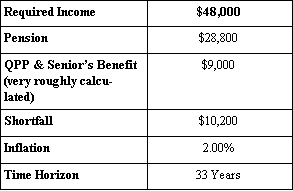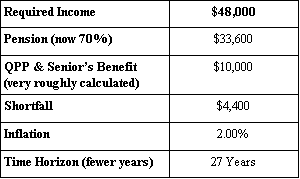
|
|
Step Six - Develop a Financial Plan
Using the same example we determine the following:

RRSP Options to Cover the Shortfall
Currently their $80,000 is invested in GIC's earning 4%. The financial planner shows Bob that in order to have
$10,200 per year for 33 years with a 4% growth rate and a 2% inflation rate he would require an initial capital
of $248,000 - far more than the $80,000 he currently has. Of course Bob could choose to live with $41,088 instead
of $48,000, as that is what his $80,000 would provide him.
An option is to postpone retirement for 5 years. If Bob does so this is what his new situation would look like:

In 5 years, Bob should have $97,300 in his RRSP. In order to have $4,400 per year, for 27 years, at 4% growth,
2% inflation Bob needs $92,500. So this plan could work.
Let's make some more assumptions. Let's assume that Bob's employer is willing to give him one years' salary as
a severance package to retire early. Can Bob retire? Bob decides to roll the entire $48,000 into an RRSP and now
he has $128,000 in his RRSP. The financial planner shows Bob that he would be able to retire early if he were to
make 10% instead of 4% as the lump sum required to have $10,200 per year for 33 years at 10% with 2% inflation
is $124,791 which is less than his $128,000.
So the choice is now Bob's - work five more years and maintain his investments as they are, or retire early and
invest in investments that have historically returned 10% or more.
In order to continue with the remaining financial planning steps, we will assume that this is what Bob does and
that the planner advised Bob to invest in a portfolio made up of a balanced fund and an international fund so as
to obtain his 20% foreign content.
Obviously Bob wants to move his severance pay into his RRSP without paying tax. Can he do so? He has 30 years service.
It is 1997 and the rules regarding rollovers allow for service up to 1995, so 28 years can be transferred to an
RRSP. The rule is $2,000 per year of service and for years up 1989. An additional $1,500 can be transferred for
years where the pension was not vested. In this case it doesn't matter as Bob's severance pay will not exceed 28
x $2,000 = $56,000. If it did we would consider unused RRSP carry-forward room and the $2,000 overcontribution
allowable.
If Bob was over age 69 he could not roll his severance pay into an RRSP as he is at RRIF age. In this case, he
would be better advised from a tax point of view, to ask his employer defer a portion of the severance pay to the
following year. Sometimes you can negotiate this with the administration.
Step Seven - Implement the Plan
Once the plan has been prepared, the rest is largely mechanical. The proper forms must be completed to move RRSPs
from one institution to another and to ensure that the retiring allowance moves into Bob's RRSP without being taxed.
A good financial planner will also perform a complete personal financial review if not already done. This will
enable the planner to assist with other plans (estate, insurance, children's education. travel, etc.).
After the review is done, there may be other financial planning strategies which are of interest to Bob and Julie.
Step Eight - Monitor the Plan
It makes sense to monitor the plan to ensure that both the investments are doing what they should be doing,
and to ensure that there is not a change in the family environment brought about by returning to work, divorce,
inflation, death in the family, health concerns, moving to another province or country, change in retirement goals,
new tax legislation etc.
You should contact your planner whenever you have a concern. Your planner should contact you several times during
the year by phone or in person. If your planner has conducted a personal financial review and understands your
goals and objectives, the frequency and length of these visits can be shortened.
back to main page